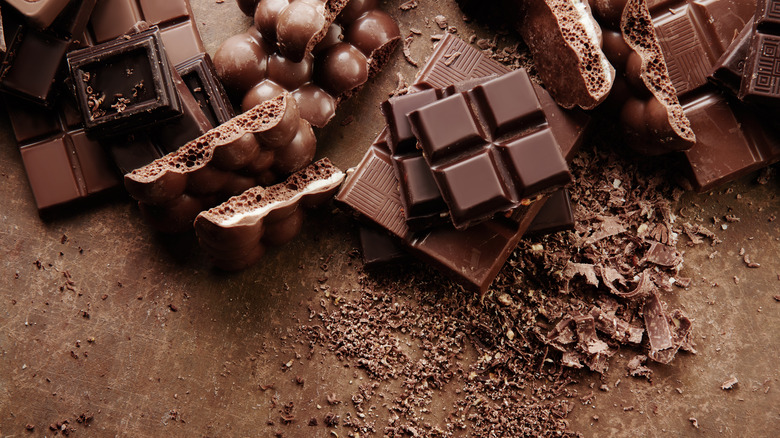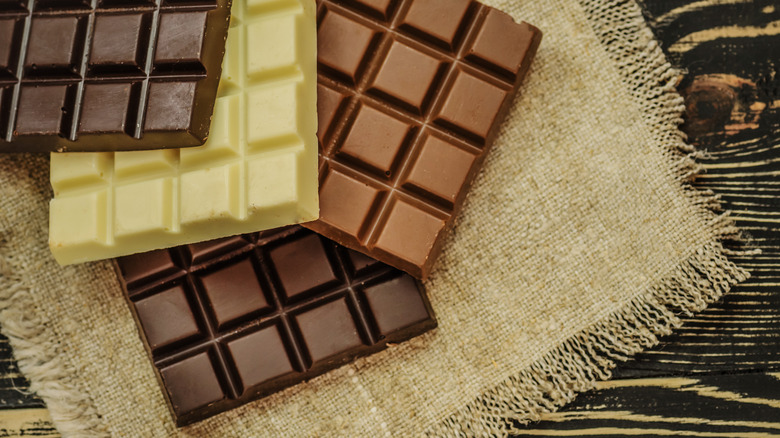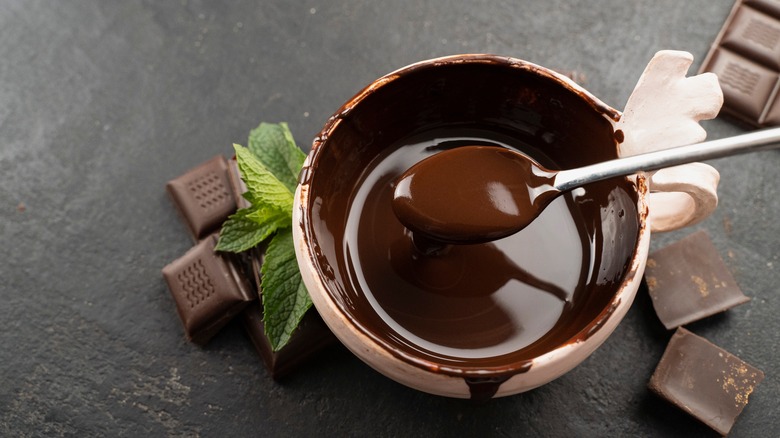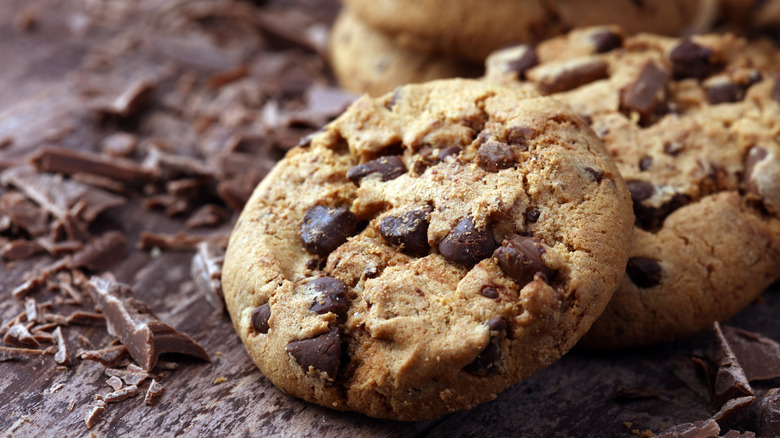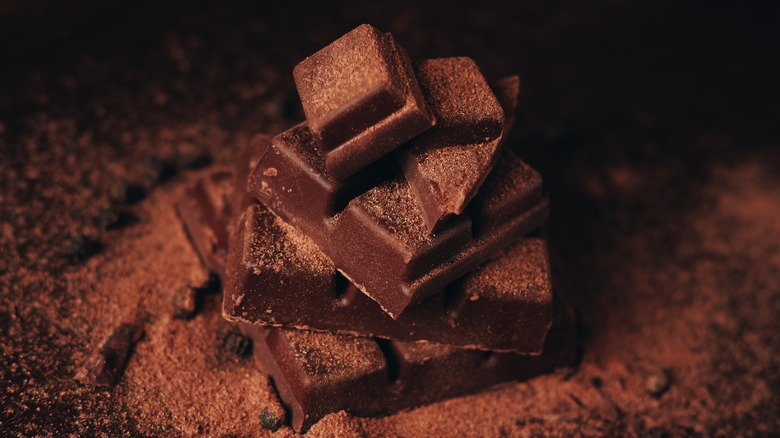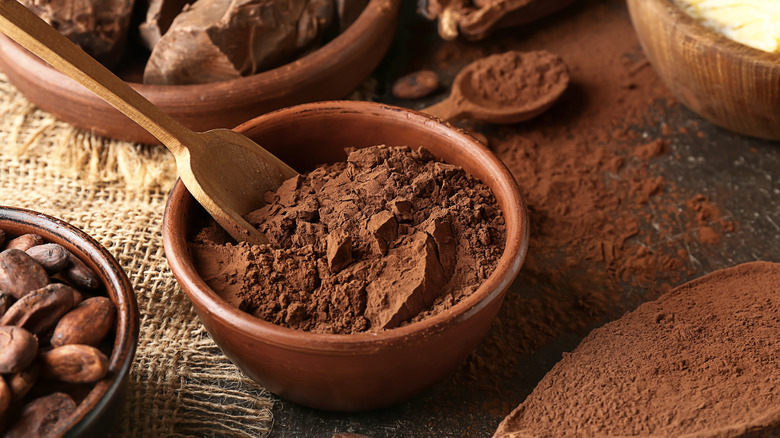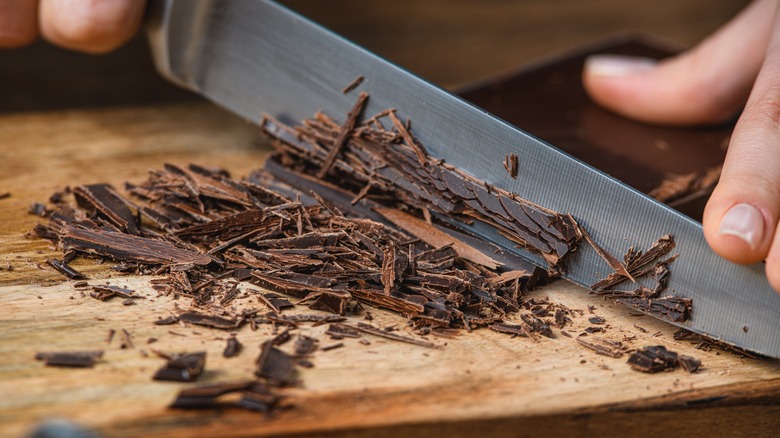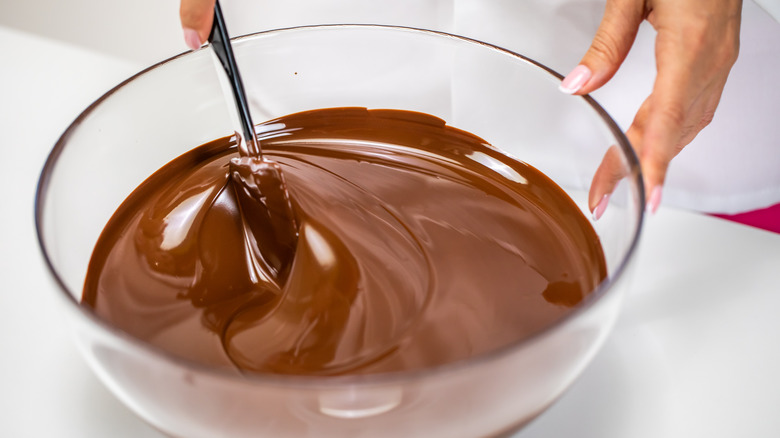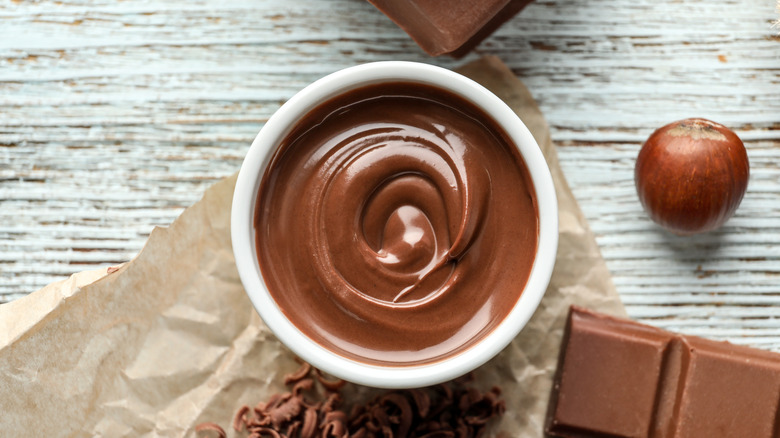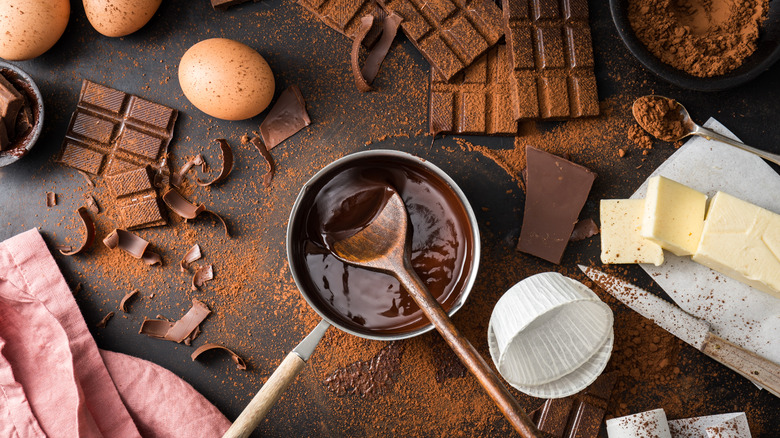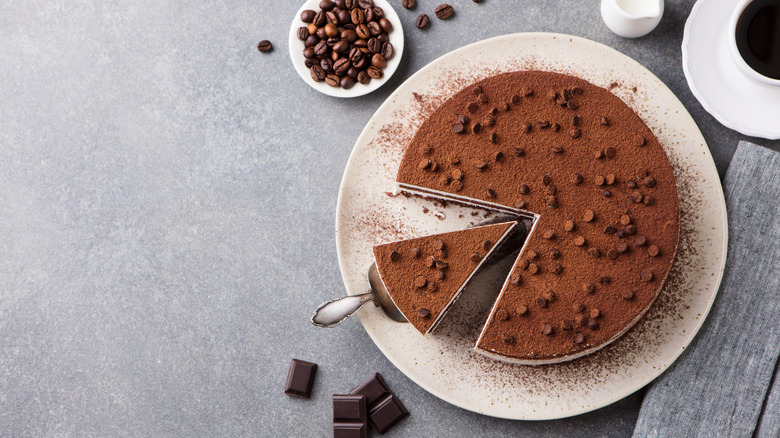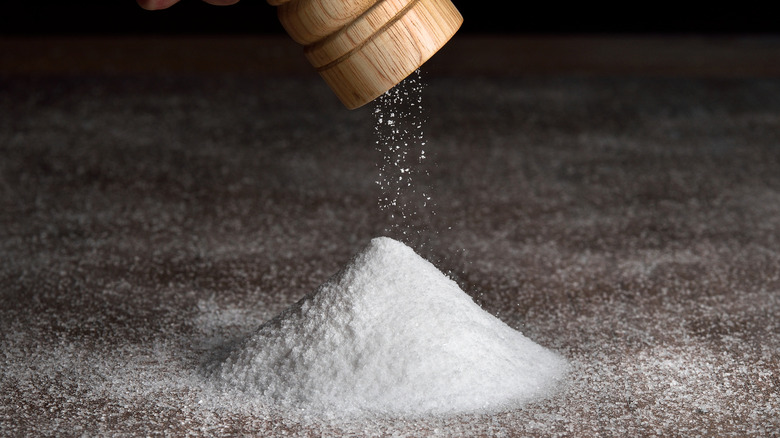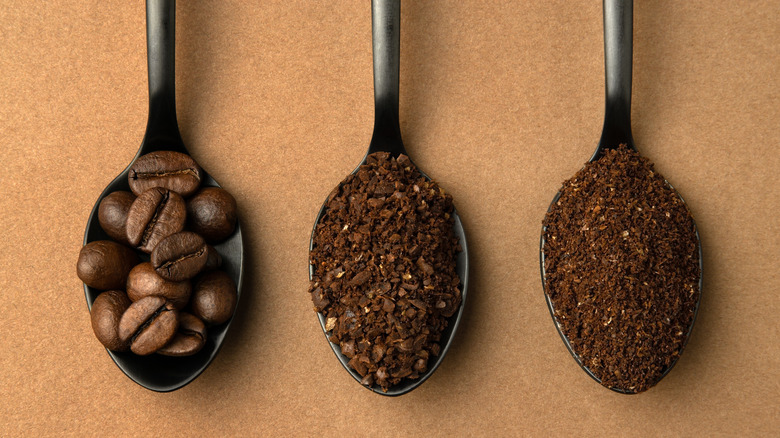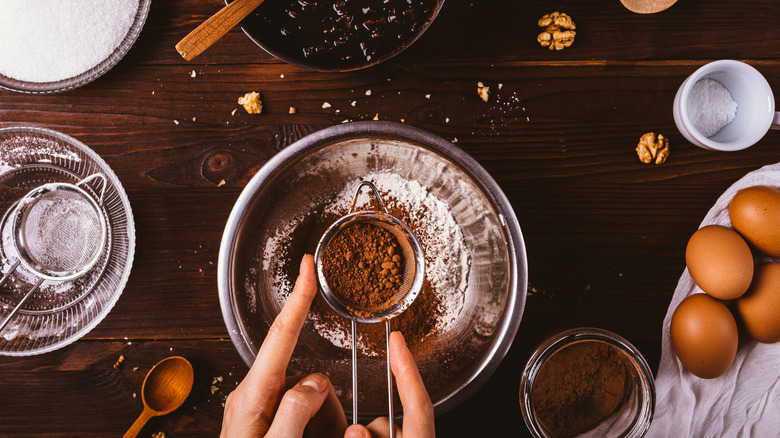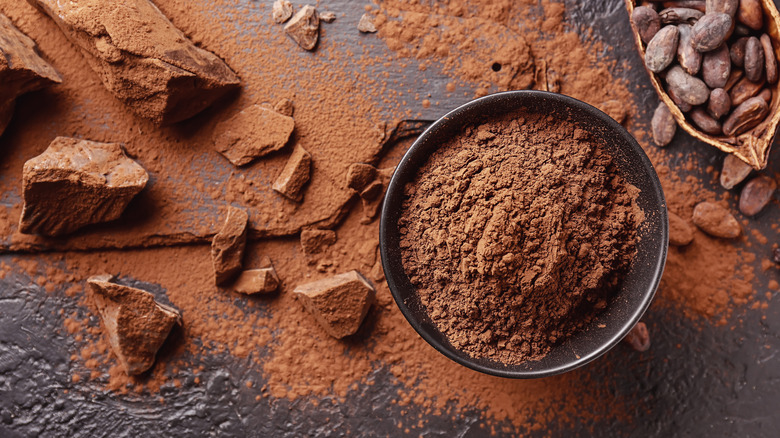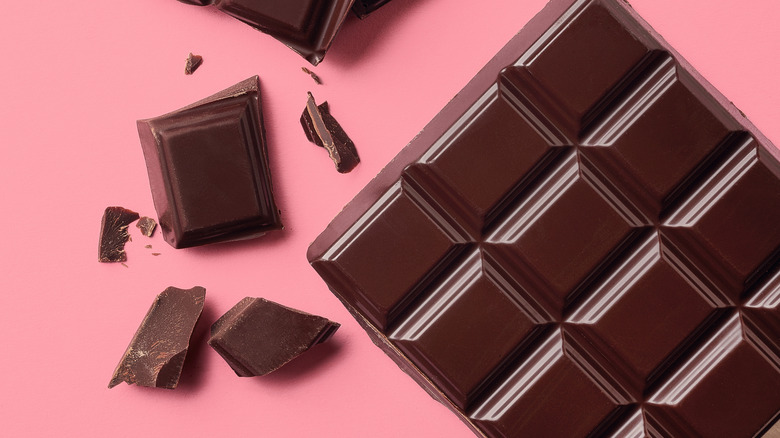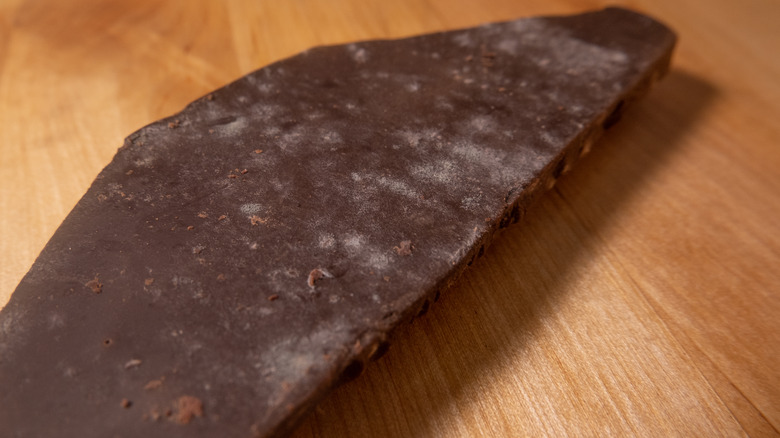The Biggest Mistakes You're Making When Cooking With Chocolate
Ever since the Mayans put chocolate on the map, the entire world has been hooked on cacao. Centuries since its discovery, chocolate continues to be one of the most popular sweet treats in the world, and Americans ate $18.27 billion worth of it in 2015 — about 18% of the world's total chocolate consumption (via CNBC). We're consuming chocolate in any way that we can: eating it plain, drinking it in its liquid form, in baked goods, and even in simple flavorings.
While we certainly enjoy eating chocolate, cooking with it is easier said than done. When you nail this temperamental ingredient, the results can be marvelous. But get the tiniest thing wrong, and you'll be left scratching your head wondering why you can't recreate that perfectly moist chocolate cake from the restaurant, or where you went wrong with the recipe that promised fudge-y brownies. From allowing a drop of water to sneak into your melted chocolate to not picking the right type of chocolate bar, here are the biggest mistakes you're making when cooking with chocolate.
Not using the right kind of chocolate
All chocolate is not the same. Depending on the recipe, choosing the right kind of chocolate makes all the difference. Cook's Illustrated says white chocolate has a silky texture that's best used in desserts where you want a subtle taste of milk and added creaminess. But since there's no cacao in it, don't expect it to add a chocolatey flavor to your dish. Dark chocolate tends to have more complex flavor profiles when it's the starring ingredient. Craftsy adds milk chocolate melts easily and is the ideal type of melting chocolate to go on top of a dessert.
Semisweet and bittersweet chocolates can be interchanged in any dish relying on chocolate. But, if a recipe calls for unsweetened chocolate, use that, as Cook's Illustrated says it has no substitute. Made out of pure chocolate liquor, unsweetened chocolate lacks sugar and is great for recipes where you want control over the sugar content. Cocoa powder also has a lower amount of sugar but with a more concentrated chocolate flavor. That's why it's a great addition to already sugary baked goods, like a rich chocolate cake, if you want a source of chocolate that packs in as much flavor as possible without making it taste overly sweet. It also has less fat than chocolate and is ideal for already fat-heavy baked goods where adding more could lead to a sunken cake, or if you simply prefer a chocolate treat with lower fat content.
Not taking the quality of the chocolate into consideration
Many people speculate as to whether the quality of your chocolate matters if you're only going to mix it with a handful of other ingredients when baking. But "Great British Bake Off" finalist Benjamina Ebuehi tells The Guardian that, "if you wouldn't eat [a particular bar of chocolate] on its own, you probably won't want it in your baking," which seems like sound advice.
According to Kitchen Stories, you want to use chocolate that has as short of an ingredient list as possible. Anything on top of cacao, cocoa butter, sugar, and the occasional milk powder is a red flag. Ebuehi adds that any chocolate that's made with fat and oil is no use when you're trying to melt or temper it, as it can be very unreliable (which might explain why the chocolate in your ganache splits). This, however, does not mean that you always have to splurge on a quality bar of chocolate.
In general, if chocolate is only a supporting ingredient and your dish doesn't depend on it, you can get away with using almost any quality of chocolate. But, if you're making something where the chocolate is the star — think chocolate cakes, tarts, brownies, and truffles — you might want to invest in one that's going to be both easy to work with and good to taste.
Expecting chocolate chips to melt
Folding chopped chocolate bars into cake, cookie, and brownie batters will make them ooze once they are baked. The same, however, cannot be said about chocolate chips. Anybody who has stared at a plate of chocolate chip cookies will know that chocolate chips don't melt, even if they're made from chocolate. So if you're folding chocolate chips into your doughs and batters and expecting them to leave little puddles of melted chocolate when baked, you may want to reconsider, because the chips are designed to do the exact opposite.
Mental Floss explains that chocolate chips have a lower amount of cocoa butter than baking chocolate, which makes them more resistant to heat. Some even come with added emulsifiers and stabilizers that help the chips hold their shape under heat, which is why they rarely melt during baking. This is precisely why Epicurious makes a case for making chocolate chip cookies without any chocolate chips at all. Unless you enjoy chunks of solid chocolate in each cookie bite, the site suggests sprinkling chopped chocolate bars instead, which will leave little pools of melted chocolate in the cookie.
If you absolutely must use chocolate chips for melting and don't have any other chocolate on hand, melt the chips in the microwave or on a double boiler. Mental Floss does warn you, though, to be prepared for a thicker liquid that's far from the smooth, glossy brown you want the chocolate to be.
Disregarding the cocoa percentage
When you only have one bar of chocolate at hand, it's easy to ignore the double-digit number written on top of it. Surely you can get away with using a 55% bar of chocolate instead of a 65% one, right? Well, not really. Not unless you make the necessary tweaks in your recipe to account for it.
Food52 explains that the cocoa percentage on a bar of chocolate tells you how much of the chocolate is actual chocolate. That is, how much percentage of a cocoa bean and all its parts are used in the chocolate. If a bar of chocolate says that it is 65% cacao, the remaining 35% is not chocolate, and usually sugar, milk, flavorings, stabilizers, and the like.
If you're following a recipe that calls for a bar of chocolate with a certain percentage of cocoa, it's wise to stick to it. Using a lower percentage will mean that the chocolate may have more sugar than the recipe overall accounts for, whereas using a higher percentage will mean that you'll want extra sugar on top. Ricardo Cuisine even found that when using a chocolate with 85% cacao in a ganache recipe that called for 57%, the ganache split and turned out to have a grainy texture.
Not using cocoa powder to flour your pans
Even better than the actual process of baking a chocolate cake is watching it gracefully slide off the baking tin once it's nice and cool. The rich shine, the deep brown color, the little pockets of air — it's glorious. Except, there's that pesky layer of white powder on top because you floured the baking pan with white flour.
According to the Los Angeles Times, while flouring pans is a crucial step that prevents cakes from sticking to the pan, there's a better ingredient than white flour that you could be using — cocoa powder. If you wouldn't dust chocolate truffles with white flour, why dust baking pans with it?
When it comes to chocolate-based recipes, cocoa powder will not only do the same job as flour, but it will do it without the white hue. It'll also add an extra kick of chocolatey flavor to the cake. Reddit users, however, warn that it's best to use unsweetened cocoa powder for flouring pans. Sweetened or semisweet cocoa powders often contain sugar in them, which will make the powder caramelize on the bottom of your baked goods under the heat of the oven.
Not chopping chocolate before melting it
It may be tempting to snap a bar of chocolate into bite-sized pieces and throw it in a bowl to melt, but there's a good reason why you should be going the extra mile to chop it instead. Unless the pieces of chocolate are already in a uniform size, like chocolate wafers, chopping chocolate slabs into small shavings will make it melt faster and more evenly, as well as make it less likely to burn in the process (via The Spruce Eats).
According to Real Simple, even though chopping chocolate seems simple enough, there are a few neat tricks that can make the process even easier. Warming chocolate bars in 10-second intervals will soften a cold and hard bar of chocolate, making it more pliable for chopping. Make sure to warm the chocolate only till the corners begin to shine, otherwise, it can quickly start melting into a liquid puddle.
Using a serrated knife will also make it easier for you to chop a bar of chocolate that has a smooth surface. If you don't want your chocolate shavings to go all over the counter, it's also a good idea to anchor the chopping board by placing a wet towel underneath as it will lock the chopping board in its place!
Not being careful while melting chocolate in a microwave
Many chefs and home bakers swear by the double boiler method when it comes to melting chocolate. But anyone with a microwave will know that it's just so much more convenient to use the nifty appliance instead. All you need is a bowl and a few seconds of heating!
Melting chocolate in a microwave, however, is a more convenient method — in theory. Microwaves tend to heat food unevenly (via GoodHousekeeping). This is why if you aren't careful with it, the chocolate will be more susceptible to overheating and burning. Food52 also says that when you're melting chocolate, you want the microwave settings to make sure the chocolate is warm and not hot. This means that the power of your microwave should be no higher than 30% to 50%, and certainly not 100%.
You should also pause the microwave at frequent five-to-15-second intervals to check on your chocolate and give it a good stir. Lowering the microwave's power and stopping it at frequent intervals is the key to making chocolate melt smoothly in a microwave without it burning.
Allowing moisture to sneak into your melted chocolate
Moisture is sometimes chocolate's worst enemy. When you're melting your chocolate into a glossy brown liquid, allowing even the tiniest bit of moisture in can make the chocolate seize up (via Food52). This means that wet bowls and spatulas, or damp hands, can easily make your chocolate clumpy.
According to Cook's Illustrated, chocolate contains three main ingredients — cocoa powder, cocoa butter, and sugar — which melt evenly into a satiny liquid. Adding a small amount of moisture to chocolate will turn the sugar in it into a syrup, and the cocoa particles will stick, seizing the melted chocolate into grainy sludge. Per Food52, Harold McGee compares this to the same thing that happens with water and flour. When you add a few drops of water to dry flour, it will turn into a paste. But if you add some more, it will be lump-free.
Similarly, you can fix seized chocolate by adding more liquid to it. Use it in any recipe that calls for chocolate melted in a liquid-like butter or cream — think brownies and mousses. But if you intend to use the melted chocolate for dipping or coating where adding liquid into the chocolate would not work, it's best to start over.
Not using butter or oil to melt chocolate
While chocolate can be melted by itself, adding oil or butter to it can make a whole lot of difference. Ingredients like butter and oil increase the fat content of the chocolate when it is melting (via KitchenSeer). The higher fat content will help the chocolate melt more smoothly, improve its texture, make it more spreadable, lower the temperature that the chocolate will harden, and give the chocolate a glossy hue when it hardens. Plus, mixing butter with chocolate will help combine any additional ingredients with the chocolate. It's also the key to saving seized chocolate.
When using butter or oil to melt chocolate, however, there are a few things to keep in mind. It's best to use a neutral-tasting oil or butter — you don't want your chocolate to taste like sesame oil or herby butter unless the recipe asks for it. You should also be careful that the butter is not too cold as the chocolate will be more susceptible to seizing otherwise. Make sure to also melt the butter and chocolate together over low heat so that it doesn't overheat and make the chocolate's cocoa butter float in a separate layer on top, says The Infinite Kitchen. In general, a tablespoon of butter or oil for every 12 ounces of chocolate chips or shavings is enough to help thin and melt the chocolate.
Not blooming your cocoa powder
Blooming coffee in hot water is a common lingo in the coffee world, and blooming spices in hot oil is an unspoken rule of cooking. Another important element is blooming cocoa powder while baking. Blooming cocoa powder essentially means adding some sort of hot liquid to it — water, milk, coffee, butter, or oil — allowing it to dissolve and then cooling it down before you use it (via The Spruce Eats).
Hot liquid can extract flavor from cocoa powder, similar to how it extracts the flavors of coffee or spices. While hot liquid extracts the flavor of the cocoa powder, it also intensifies the flavor of chocolate in it, meaning you get way more from the cocoa powder than you would if you were using it dry.
When blooming cocoa powder, make sure that the liquid is not too hot as that can make the powder bitter. Be sure to cool down the bloomed cocoa completely as a still-hot cocoa powder mixture can pre-cook other baking ingredients. It's also important to only bloom the cocoa powder in recipes that call for enough liquid for the powder to dissolve. Additionally, if a certain recipe requires that an ingredient be used cold (like cold butter), it's best not to melt and heat it with cocoa powder.
Forgetting to add salt
Just about every recipe with chocolate calls for a pinch of salt. The salt is no typing error and it doesn't imply that the dessert is meant to have a salty flavor. Salt, it turns out, is added to enhance the flavor of the chocolate! According to The Chocolate Journalist, the relationship between salt and chocolate goes far back to when salt was considered a form of currency in ancient Rome like cacao was among the Aztecs.
Today, salt is added to chocolate more for its taste rather than its value. Salt, the site says, heightens our ability to taste the sweet flavor of sugar whilst also adding a nice and salty contrast to the sweetness of chocolate. It can also make the flavors in chocolate pop more. Salt can mask the chocolate's bitterness, balance out its flavor, bring its more subtle notes to the forefront, and even help chocolate in releasing its delicious aroma (via Art Chocolat).
Since salt will not melt in chocolate, make sure to mix and blend it thoroughly when adding it. Alternatively, you could also sprinkle larger crystals of salt on top of chocolate baked goods like cookies. The key, however, is in adding the right amount of salt to chocolate. You want the salt to make the chocolate taste better, not to add a salty flavor of its own, so a tiny pinch is all you need (just like the recipes say).
Coffee enhances chocolate, too
Much like salt, coffee and chocolate are a very common pairing and you will never be short of finding chocolate-based coffees or coffee-filled desserts. When it comes to chocolate, though, a touch of coffee powder or espresso can greatly enhance its flavor without making the dessert taste like coffee (via Taste Of Home). According to The Kitchn, coffee can even deepen the flavor of chocolate by making it taste darker and richer than it is.
You can use one of three ways to add coffee to your chocolate in baking. Instant coffee can be mixed into the batter with the other dry ingredients, or you could bloom coffee powder in hot water with your cocoa powder. You can also add espresso powder, however, this tends to be far more concentrated than instant coffee, so you only need about a teaspoon of it (via King Arthur Baking). The third option is pouring brewed coffee into the liquid batter. When using this option, it's best not to use more than a cup of coffee so that it doesn't overpower the chocolate. Additionally, you should also account for the additional liquid in your batter when adding brewed coffee and lessen the proportion of other liquids accordingly.
Not sifting cocoa powder
There are certain steps in baking that simply need to be followed, whether or not they are explicitly mentioned: Use your ingredients at the right temperatures, level your ingredients to measure them accurately, and sift all your dry ingredients, not just the flour. Art Chocolat stresses that sifting may be particularly important when you're using cocoa powder as its granules tend to be very fine, which makes it more prone to clumping together in the container.
While shifting will get rid of lumps, Taste of Home also notes that sifting incorporates air into dry ingredients, making them lighter and easier to mix into a batter with wet ingredients. Plus, it will also ensure that you have the accurate measurement of cocoa powder in your recipe and you won't be left with dry lumps of powder in your finished item.
If the only thing stopping you from not sifting cocoa powder is the lack of a sifter, you can use the same strainer you use to drain pasta water for sifting cocoa powder. Alternatively, you can run a whisk through your dry ingredients to break any big lumps of powder. If it's a particularly large batch of cocoa powder, there's also the option of running it through a food processor.
Using Dutch and natural cocoa powders interchangeably
Cocoa powder comes in two types — natural and Dutch — and they're not necessarily interchangeable. According to Serious Eats, cocoa powder is what remains of cocoa beans after they are dried, roasted, and fermented. Natural, or non-alkalized cocoa powder, is roasted cocoa bean powder at its finest (via Food52). It has a concentrated flavor of cocoa beans and retains the bean's acidic and tart flavor profile. Dutch, or alkalized cocoa powder, goes through chemical treatment that makes it far less sharp and acidic as well as a darker shade of brown. When you're using cocoa powders in recipes that don't need to be baked, you can choose any cocoa powder based on your taste preferences. But if it's baking that you're using it for, you might want to reconsider your choice. Serious Eats notes that the varying acidity levels are what makes the two cocoa powders very different.
Recipes with chemical-based leaving agents like baking powder and baking soda require the use of ingredients with appropriate levels of acidity to give the food its rise. This means, that if a recipe calls for baking soda, it most likely needs the higher acidity of natural cocoa powder. If it calls for baking powder, it's Dutch cocoa powder that you need. Using the wrong kind of cocoa powder will compromise not only the flavor of your baked good but also its texture — no wonder baking is often compared to a science experiment.
Not storing chocolate correctly
In 2020, Cadbury Australia finally put an end to the how-to store chocolate debate with a definitive tweet: "Chocolate should always be stored in a slightly cool, dry, dark place such as cupboard or pantry at temperatures less than 21 C to ensure the quality isn't compromised." So the bar of chocolate that you've been storing in the coolest corner of your refrigerator is not exactly where it should be stored.
According to readcacao, when you're storing chocolate in the refrigerator, you're risking the chocolate absorbing the odor of other strong smelled foods sitting next to it (chocolate pudding tastes suspiciously like an onion? You know the culprit). The humidity of the refrigerator can also add moisture to the chocolate, affecting its taste and causing it to spoil (via The Kitchn). Additionally, when you remove it from the cold temperatures of the refrigerator and suddenly expose it to the warm temperatures of cooking, you risk the chocolate blooming due to the temperature fluctuation.
You should also not be storing chocolate or chocolate-based products close to a stove as the heat can melt chocolate and affect its taste. The best way to store chocolate is in air-tight containers at cool room temperatures away from heat.
Using bloomed chocolate for dipping without tempering it
When chocolate isn't stored correctly or undergoes drastic temperature fluctuations, it can develop a bloom — a thin layer of white on top (via Cook's Illustrated). When the chocolate has been softened, it develops what is called a cocoa butter bloom. When the culprit is the evaporated water from the condensation of moisture, the white layer is called a sugar bloom.
While a bloom only affects the appearance of the chocolate and not its flavor, there are certain situations when you should not be using bloomed chocolate. Bloomed chocolate can be used as normal when you're incorporating it into a batter for cakes and brownies, but if you're melting bloomed chocolate and using it to dip cookies or strawberries, be prepared for the white bloom to reappear once the chocolate hardens. It also won't have that snapping sound that is the sign of well-tempered chocolate and will crumble instead (via The Guardian). If you do want to use bloomed chocolate for dipping, you might want to take the time to re-temper it so that the bloom disappears and gives way to a glossy sheen.
